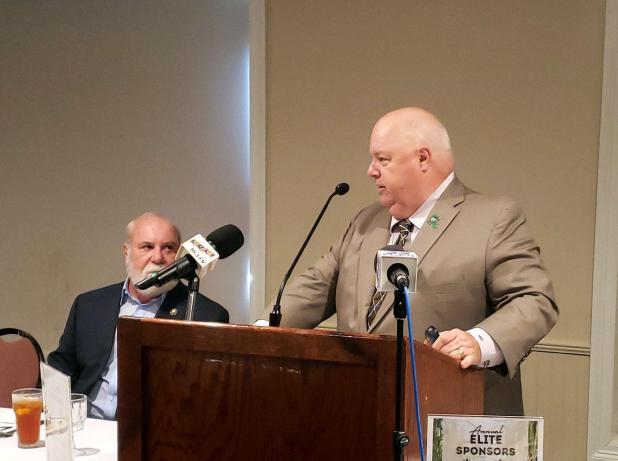
Agriculture Commissioner Mike Strain speaks Wednesday at a St. Mary Chamber Business Luncheon in Franklin.
The Review/Bill Decker
Ag commissioner talks about challenges, opportunity
FRANKLIN — Louisiana Agriculture Commissioner Mike Strain talked to a St. Mary Chamber luncheon audience Wednesday about one state department. But he might have taken a line from “A Tale of Two Cities.”
For Louisiana farmers and the Agricultural and Forestry Department, this can be the best of times and the worst of times.
Strain spoke at the Chamber Business Luncheon at The Forest restaurant
The worst of the current season results from the statewide drought.
“We’ve never seen a drought this severe,” Strain said.
The dry weather and acres and acres of trees downed by the 2020-21 hurricanes have fueled a whole series of wildfires beginning in August, most notably the Tiger Island fire in Beauregard Parish. That blaze eventually spread to 31,000 acres beginning Aug. 21.
The Agriculture Department is equipped with specialized vehicles and expertise in fighting wildfires. But Ag Department personnel and volunteer fire departments were on their own for five days after the Tiger Island fire was ignited until help from 26 states began to arrive.
Volunteer firefighters “did yeoman’s work,” Strain said. “But they are underfunded, undertrained and understaffed” for a fire that lasts for days.
The fire eventually came within 3,200 feet of homes in Merryville, Strain said, despite the efforts of firefighters, retardant dumped by Blackhawk helicopters and water from “scooper” planes that made round trips between Toledo Bend and the fire zone.
Some of the wildfires started accidentally, Strain said, including one ignited by sparks from a chain dangling from a moving truck. At least four fires were the result of arson.
The drought in states in the Mississippi and Ohio River valleys reduced the Mississippi River volume, leading to saltwater intrusion. That’s a problem for rice and crawfish farmers, Strain said.
The hardest hit crop so far has been hay, Strain said. There are already signs that more cattle are being sent to market as producers try to avoid paying increasing hay prices. Yet cattle prices haven’t shown a significant drop, Strain said, a sign that demand remains high.
In St. Mary, sugar cane accounts for two-thirds of the parish’s crop production. So far, the prospects for this year’s crop and current prices are favorable, he said. Louisiana is the nation’s biggest producer of a sugar crop expected to be worth $2 billion.
For a decade, Strain said, the world has fallen short of the 2% yearly increase in food production needed to keep pace with the population. And much of the marginal land that could be converted to agriculture is already in use.
That means the emphasis will be on increasing production in the currently available acreage. Strain said he’s working with LSU and Southern to develop ways to boost crop yields.
“We have to make sure we protect every inch of every acre ...,” Strain said.
“The future of Louisiana growers has never been brighter.”
